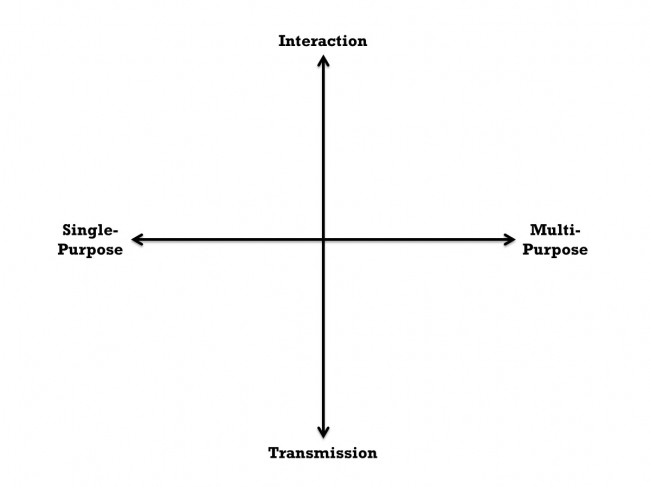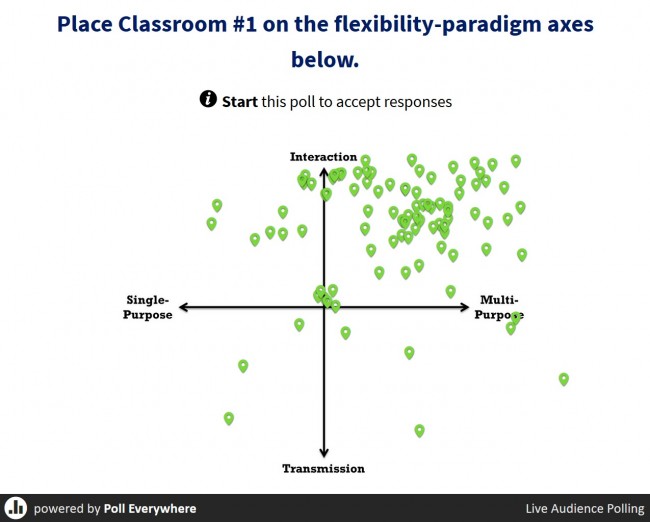Creating Active Learning Environments at the Next Gen #LearningSpaces Conference
by Derek Bruff, CFT Director
A couple of weeks ago, I had the opportunity to design and facilitate a workshop for the Next Generation Learning Spaces conference here in Nashville. Faculty, staff, and administrators attended the three-day conference to explore new ideas at the intersection of learning spaces, technology, and pedagogy, pretty much my favorite intersection in all of higher education.
My session, held in the Library Community Room here on campus, was titled “Creating Active Learning Environments: One Way or Another.” The title of the session is borrowed from the subtitle of my book, Teaching with Classroom Response Systems: Creating Active Learning Environments, published in 2009 by Jossey-Bass. For my learning spaces workshop, I wanted to extend the idea that new technologies (like classrooms response systems) and student-centered pedagogies (peer instruction, for instance) can be used to create active learning environments in almost any classroom.
At one point in the workshop, I showed participants photos of three classrooms and asked them the following questions: When you look at these classrooms, do you expect them to be places of transmission of information or of interaction among students and faculty? And do you see these as single-purpose classrooms or ones that supports multiple different teaching practices? That is, where would you place each classroom on the following axes?
 To make that point that technology can enhance an active learning exercise like this one, I asked participants to report their answers using Poll Everywhere, a classroom response system that features a “clickable image” question type. As participants responded on their laptops, tablets, and smartphones, I displayed a graph of their answers, which I used to lead whole-group discussion:
To make that point that technology can enhance an active learning exercise like this one, I asked participants to report their answers using Poll Everywhere, a classroom response system that features a “clickable image” question type. As participants responded on their laptops, tablets, and smartphones, I displayed a graph of their answers, which I used to lead whole-group discussion:
This was my first time using Poll Everywhere’s “clickable image” question type (a type I’ve called a “placemark question” in the past), and I think it went very well. The coordinate axes (loaded into Poll Everywhere as a simple image) provided participants a useful tool for analyzing the classroom photos I shared; the use of the response system made it clear that I really expected everyone to participate and submit answers (“all skate”); and the aggregation of responses made possible by the response system allowed me to lead discussion in a way that was responsive to the perspectives and ideas in the room. This kind of activity could be implemented in just about any classroom, even a stadium-seating lecture hall, provided the room had Wifi or cellular coverage.
For more on this activity, including photos of the three classrooms the workshop participants analyzed, see my blog post, “Learning Spaces + Coordinate Axes + Placemark Questions.” For some really creative ideas (submitted by workshop participants) on creating active learning environments in particular kinds of classrooms, see my follow-up blog post, “Hacking the Classroom: Ideas from the Next Gen #LearningSpaces Conference.” And my workshop slides are available, too.
One final point: I strongly support instructors making creative and effective use of the learning spaces they’re given, but I also think it’s important that the classrooms we teach in are well-designed, flexible, and support active learning. If you’re involved in classroom design or redesign here at Vanderbilt, feel free to contact me to discuss how the Center for Teaching can assist in your design process.


Leave a Response